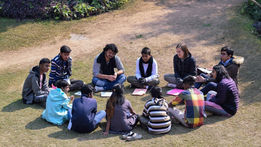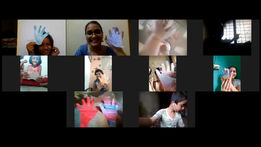Reimagining The System
Act now to reimagine education!
Kids can bring about change in the education system. Through small, regular actions over time kids can work with educators to actually change the education system. We encourage you to attend education conferences, ask if you can assist your local education department and even see if you can engage with education policy.
Here’s how you can start! Below you will find stories, learnings and exact steps you can try out to achieve what
these kids and educators did. Click on the resource that you'd like to learn and get started.
Let’s reimagine education together!
KERxGlobal
How can you begin reimagining education from anywhere in the world?
Kids Education Revolution works on spreading its 3 Principles [Kids and Educators as Partners, Kids as Changemakers, and Safe Spaces for Voice] and 8 Cs [Creativity, Critical Thinking, Collaboration, Communication, Courage, Consciousness, Compassion, and Curiosity]. We believe that if these principles and skills were implemented in every classroom, school, community and education system, then we would have reimagined education. There are many ways to drive this change, but we choose the approach of love. As we become more aware of the many things that need reform in education, we respond with care and partnership.
In August 2020, we organized a 3-day workshop in collaboration with Teach For All for Educators from across the globe. Educators from 40 countries in the Teach For All Network joined in to know how they can implement the three principles and build the 21st Century Skills in their kids. The workshop series had attendees coming from 28 countries, namely, Albania, Argentina, Bangladesh, Brazil, Chile, Colombia, Gambia, Hong Kong, Ghana, India, Japan, Kenya, Malaysia, Lebanon, Peru, Portugal, Singapore, Qatar, Spain, Nepal, Nigeria, Taiwan, Tanzania, Uganda, UAE, US, and Zambia. Approximately 40 educators immersed themselves in the three principles and 8 Cs of KER and found ways to contextualize and take back ideas on reimagining the education system.
How can you take back our principles and 8 Cs?
Firstly, we request you to first take the time to go through the following to understand the Principles, 8 Cs, and the Approach of Love. Each of these pages are filled with short explanations and beautiful examples that will help you to really understand what they are about!
Acting on these principles will reimagine education.
Love is our approach to changing the education system.
Our C's are the skills that prepare our children for the 21st century.
Moving forward, we will be presenting to you an array of resources that will help implement each of the above! As you go through these resources that will help you answer the ‘how’ of reimagining education, please be sure to think of these questions as you learn -
What are you learning about safe space for voice, partnership and changemaking?
Is it sparking any ideas or thoughts that are relevant or helpful to your context?
We will come back to these questions at the end of this resource.
How do you build student-educator partnerships to reimagine education?
How do you build platforms that enable safe space, partnership and changemaking?
How can you build Student Leadership?
After learning from all these powerful stories and impactful resources, think about these questions -
What are you learning about safe space for voice, partnership and changemaking?
Is it sparking any ideas or thoughts that are relevant or helpful to your context?
Do share your thoughts and ideas with us. We are learning as we grow and we would love to hear from you.
Revolutionary Council
How do you run a Student Advisory Council?
The KER Revolutionary Council is a collective of 6 students working in collaboration with the Kids Education Revolution staff team to design and execute our strategy for 2020-21. The steps given below will take you through what goes into running such a structure by highlighting the support, training and processes we put into place.

At KER, we are constantly trying to deepen our understanding of the 3Ps. This year, in an attempt to understand partnership in its truest essence, we set up a student advisory council that would partner with us in executing our projects for the year. We are currently working with 6 student leaders who are executing different pieces of our strategy such as planning and holding virtual spaces at Retreats and Conferences, leading our Communications efforts and partnering with us in conducting our Impact Study.
The core goals for the Revolutionary Council were -
Bringing in student voice in our work by having students as active partners in the design and execution of our priorities
Students exploring and building their own leadership skills
Professional development for our staff team by immersing in the ‘how’ of partnership
How can you work with a group of young leaders through the year?
1.
Selection:
Create a one-page document highlighting the expectations from the role and share it with your student community along with a registration form.
Create and share the application form and pre-work with the interested candidates.
Create a 'Reviewer's Scale' for yourself to score the submitted applications and shortlist candidates for the next round.
Host a group discussion between the shortlisted applicants.
Select the final set of candidates and host personal interviews to assess their overall fit, motivations and communication skills.
Finalize your selected council members based on their performance in the personal interviews and communicate it with the candidates!
2.
Onboarding:
Host a 2-day orientation and induction event with your council where you can highlight your vision, approach, strategy and the role they would play over the year.
3.
Leadership Development Journey Conversation::
Start the year with having individual conversations with each council member about aligning on the areas of work they would focus on, their learning goals and the kind of support structures they'd need for their growth.
You can have these conversations with the council members regularly, i.e. once in a few months to reflect on progress to goals, reassess learning goals, and gather feedback on the support you have provided them.
4.
Support Structures:
Hold check-in conversations with each council member once in a month to track progress and identify where they would require support from you.
Host group reflective spaces to collectively reflect on their growth and align or assess their progress to goals.
Design a professional development program for the council members to learn skills that are required for them to do their work, such as, managing time, backward planning etc.
5.
Partnership with the team:
Align with your organization's or project's team on the areas of work where the advisory council will be contributing.
Ensure that the organizational or project team members are checking in with the council members regularly to check on their progress.
6.
Student Projects:
Co-create a completely student-led project with the council that would span over a few months.
In partnership with the council, set a clear purpose for the project along with outcomes and goals.
For example, at Kids Education Revolution, the Revolutionary Council conducted focus group discussions to gather student perspectives on the National Education Policy 2020 which were put together in a document and shared with Teach For India's community. Currently, the Revolutionary Council is working on designing and executing a day-long retreat for other students. This space will be focusing on building a community of changemakers and explore what leadership during the COVID pandemic.
How is your Student Advisory Council running?
RTE Awareness
How do we bring an excellent education to more kids?
Several children are unable to access the right schools due to a lack of awareness of the Right to Education Act. According to Section 12 (1)(c) of the Act, all private-unaided schools must reserve 25% of their seats for children belonging to the economically weaker sections or disadvantaged groups from the neighbourhood and provide them admission to their school. This resource will help you understand an effective way to spread awareness and help more kids and adults leverage the Section 12 A(C) of the RTE Act to access an excellent education.
How did Anjali spread awareness on the RTE Act in her community?
Anjali, a 12th grader from Pune started a project in her community where she worked on spreading awareness about the Right to Education (RTE) Act and secured admissions for 7 children in private schools.
How can you help kids in your community to secure admissions through the RTE Act?
Find a team of students in your classroom, school or community who are interested in working towards spreading awareness of the RTE Act.
Hold an orientation session for the students so that the team is aware about RTE Section 12c, before you and your team start spreading awareness amongst the people of the community.
Start a simple survey of your community to collect basic information. Make a list of all the students and the schools they're going to.
Hold a meeting with your team and conduct a session to teach them how to conduct a survey.
Conduct these household surveys across the community.
Carefully collect the data.from the survey and map out all the eligible families.
Call the kids and their parents for an orientation and information session about the RTE Act Section 12c.
Once you have the permission from the kids and parents, enter the kids’ details on the government website.
Wait for the allotment result and hope these kids get admitted to schools!
Let us know how your experience was!
Want to know more about Anjali’s story? Watch the video below.
The Greatest Show on Earth
Put up a show to impact many people!
Theater is a great way to present an issue that you feel strongly about because it presents the problem in the form of a narrative that enables people to understand it. This resource helps you build a production that would present an issue you are passionate about. In this case, the production aims to tell the audience the power of listening to, and working with children.
How did these kids present the education crisis through the Greatest Show on Earth?
A Student Advisory Committee involves kids in the decision-making processes of an organization/school/classroom. This committee provides an opportunity for kids and educators to work in partnership and collectively make decisions that affect each other.
The Greatest Show on Earth was a montage of real stories from the classrooms and communities of our country which exposed the loopholes of our education system and how the system needs to be reimagined. What this show did so brilliantly that it used theater to expose the reality and a message of change and hope.
How can you set up your own show for change and hope?
Scout and form a team of actors and dancers that would be a part of your team.
Together, brainstorm and find out what is the problem that all of you are passionate about.
Identify the causes for the problem and discuss the possible solutions.
Collect real and true stories of people that have experienced this problem.
Choose a theme for the problem that you have chosen. [For example: The circus was a theme for the education system and the different characters of the circus like a juggler, acrobat, ringmaster, etc represented the different stories of people]
Stitch together your story along with your scriptwriters, while ending with the possible solution.
Plan out your rehearsals and manage your team through regular meetings and learning circles to avoid many conflicts.
Decide your date for the show and look for venues to perform.
Begin rehearsing and marketing your show through word of mouth and social media.
Be ready with a stage plan with everyone’s places marked with entry and exits for the show day and have fun!
Let us know how your show went!
Future 10x - Reimagine the system for kids, with kids.
Learning from the student-led Future10X Initiative in Colorado, USA, this resource aims to empower students to reimagine a public education system which truly prepares young people to lead in a modern world.
In the summer of 2020, Teach For America - Colorado engaged a team of students from across the state to reimagine the landscape of public education. They discovered that the potential to convene and empower students to lead requires little more than the mindset, will and minimum resources to capture learning. In this case, students collectively focused on the urgency of reimagining the public education system, while sparking similar efforts with students leading initiatives addressing global warming, hunger, etc.
How can you reimagine the local education system?
Empathize and deeply understand the perspective of others by researching through personal interviews and surveys of students, school leaders, business leaders, policy makers, parents, and educators.
Collect the data from the surveys, review the interviews and analyse the information to understand a trend that would surface as a common issue.
Perform a root-cause analysis to understand the different factors underlying the big issue or problem. Define the issue in a way that it describes the problem along with the factors and the root cause.
Collectively brainstorm to come up with ideas that could be possible solutions for the issue.
From all of the possible solutions, select the best possible solution by placing a bet based on the assumption that it will lead to the best possible outcome.
Take your time to think about what you want to achieve and in partnership with the educators, learn the following skills of creating a vision document, a long-term plan, a unit plan, and a weekly plan.
Prepare to try out your selected solution as pilot and plan out to implement it on a small scale such as at the classroom/school-level.
Execute the pilot trial. Be sure to document the progress of the participants and have the clear measures of success to measure the impact of the solution.
If the trial is unsuccessful, try again by altering the solution. But, if the trial is successful, prepare to upscale the solution to be applied at the intended level of the system.
Present your plan to the concerned authorities!
Let us know how your project is going!



















